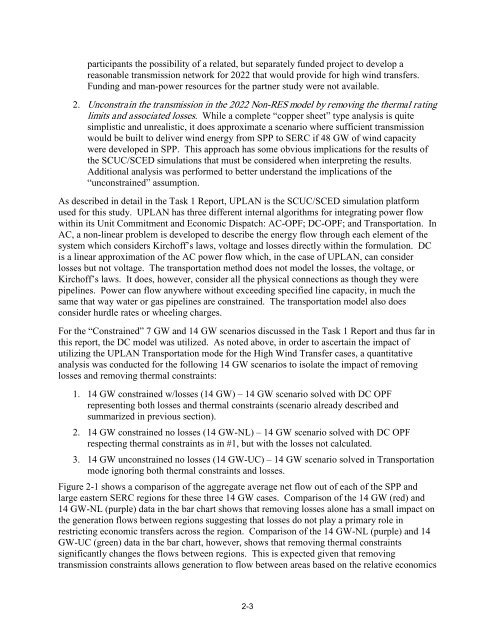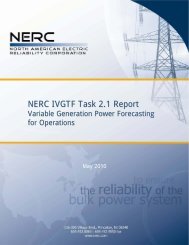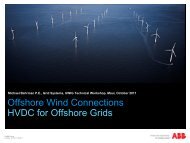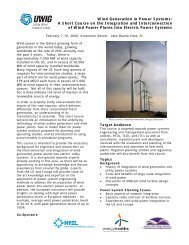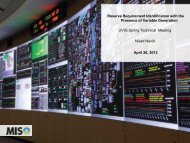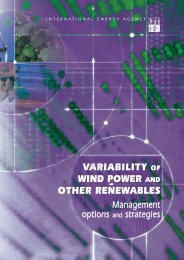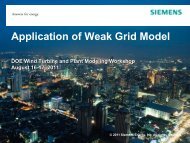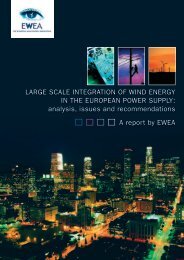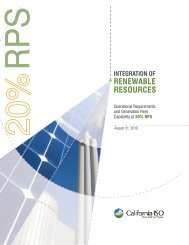Integrating Southwest Power Pool Wind to Southeast Electricity ...
Integrating Southwest Power Pool Wind to Southeast Electricity ...
Integrating Southwest Power Pool Wind to Southeast Electricity ...
Create successful ePaper yourself
Turn your PDF publications into a flip-book with our unique Google optimized e-Paper software.
participants the possibility of a related, but separately funded project <strong>to</strong> develop a<br />
reasonable transmission network for 2022 that would provide for high wind transfers.<br />
Funding and man-power resources for the partner study were not available.<br />
2. Unconstrain the transmission in the 2022 Non-RES model by removing the thermal rating<br />
limits and associated losses. While a complete “copper sheet” type analysis is quite<br />
simplistic and unrealistic, it does approximate a scenario where sufficient transmission<br />
would be built <strong>to</strong> deliver wind energy from SPP <strong>to</strong> SERC if 48 GW of wind capacity<br />
were developed in SPP. This approach has some obvious implications for the results of<br />
the SCUC/SCED simulations that must be considered when interpreting the results.<br />
Additional analysis was performed <strong>to</strong> better understand the implications of the<br />
“unconstrained” assumption.<br />
As described in detail in the Task 1 Report, UPLAN is the SCUC/SCED simulation platform<br />
used for this study. UPLAN has three different internal algorithms for integrating power flow<br />
within its Unit Commitment and Economic Dispatch: AC-OPF; DC-OPF; and Transportation. In<br />
AC, a non-linear problem is developed <strong>to</strong> describe the energy flow through each element of the<br />
system which considers Kirchoff’s laws, voltage and losses directly within the formulation. DC<br />
is a linear approximation of the AC power flow which, in the case of UPLAN, can consider<br />
losses but not voltage. The transportation method does not model the losses, the voltage, or<br />
Kirchoff’s laws. It does, however, consider all the physical connections as though they were<br />
pipelines. <strong>Power</strong> can flow anywhere without exceeding specified line capacity, in much the<br />
same that way water or gas pipelines are constrained. The transportation model also does<br />
consider hurdle rates or wheeling charges.<br />
For the “Constrained” 7 GW and 14 GW scenarios discussed in the Task 1 Report and thus far in<br />
this report, the DC model was utilized. As noted above, in order <strong>to</strong> ascertain the impact of<br />
utilizing the UPLAN Transportation mode for the High <strong>Wind</strong> Transfer cases, a quantitative<br />
analysis was conducted for the following 14 GW scenarios <strong>to</strong> isolate the impact of removing<br />
losses and removing thermal constraints:<br />
1. 14 GW constrained w/losses (14 GW) – 14 GW scenario solved with DC OPF<br />
representing both losses and thermal constraints (scenario already described and<br />
summarized in previous section).<br />
2. 14 GW constrained no losses (14 GW-NL) – 14 GW scenario solved with DC OPF<br />
respecting thermal constraints as in #1, but with the losses not calculated.<br />
3. 14 GW unconstrained no losses (14 GW-UC) – 14 GW scenario solved in Transportation<br />
mode ignoring both thermal constraints and losses.<br />
Figure 2-1 shows a comparison of the aggregate average net flow out of each of the SPP and<br />
large eastern SERC regions for these three 14 GW cases. Comparison of the 14 GW (red) and<br />
14 GW-NL (purple) data in the bar chart shows that removing losses alone has a small impact on<br />
the generation flows between regions suggesting that losses do not play a primary role in<br />
restricting economic transfers across the region. Comparison of the 14 GW-NL (purple) and 14<br />
GW-UC (green) data in the bar chart, however, shows that removing thermal constraints<br />
significantly changes the flows between regions. This is expected given that removing<br />
transmission constraints allows generation <strong>to</strong> flow between areas based on the relative economics<br />
2-3


